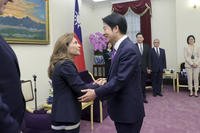The U.S. commander in Afghanistan talked up a two-year plan Monday aimed at taking back territory and driving the Taliban into peace negotiations.
Army Gen. John Nicholson's optimistic strategy contrasted with a sobering quarterly report to Congress from the Defense Department Inspector General's Office (DODIG) on the shortcomings of the Afghan military and widespread corruption in the Kabul government.
In a video news conference from Kabul to the Pentagon, Nicholson said the "conditions-based strategy" announced by President Donald Trump in August in coordination with Afghan President Ashraf Ghani had the goal of bringing 80 percent of the Afghan population under government control within two years.
"Why 80 percent? Because we think that gives them [the Afghans] a critical mass where they control 80, the Taliban are driven to less than 10 percent of the population, maybe the rest is contested," he said.
The possible result would be that the Taliban would seek a peace settlement, Nicholson said.
"And this, we believe, is the critical mass necessary to drive the enemy to irrelevance, meaning they're living in these remote, outlying areas, or they reconcile -- or they die, of course, is the third choice," he added.
Controlling Territory
Nicholson said the Afghan National Defense and Security Forces (ANDSF) control about two-thirds of the population, but he did not have an immediate breakdown on the number of districts controlled by the Taliban.
However, the IG's report showed that the government fully controls 18 percent of Afghanistan's 405 districts while another 39 percent is listed as "under Afghan government influence."
The report noted that U.S. Forces Afghanistan, which Nicholson commands, said in August that "54 of Afghanistan's 405 districts were under insurgent control or influence, an increase from 45 districts six months ago."
In announcing the new strategy in August in a prime-time address, Trump himself was skeptical of what might be achieved.
"Someday, after an effective military effort, perhaps it will be possible to have a political settlement that includes elements of the Taliban in Afghanistan. But nobody knows if or when that will ever happen," he said.
Although he did not have specifics, Nicholson said that the territory controlled by the Afghan forces is "roughly the same as last year. Now the difference going into next year, of course, is going to be this increased offensive capability."
Boosting the Afghan Special Forces
One of his main objectives, Nicholson said, is to boost the size and increase the operational tempo of the Afghan Special Security Forces (ASSF).
He said the ASSF has never been defeated in battle by the Taliban, but one of the recurring problems is that territory gained by the ASSF is later lost by the Afghan National Army or local police.
The IG's report said that expanding the ASSF from 12,000 to 22,000 and making it the "primary offensive force" would involve transferring some units from the ANA into the ASSF.
Conventional forces will still be tasked with "consolidating gains and holding key terrain and infrastructure," the report said. "However, no publicly releasable information discusses how long it will take to train the new special forces soldiers or how moving elite soldiers from the ANA to the ASSF will affect the ANA's capability."
Last week, the Pentagon confirmed that 3,000 additional U.S. troops had deployed to Afghanistan, bringing the total number of U.S. forces on the ground to 14,000.
Nicholson said the additional troops and increased air power would break the "stalemate" in Afghanistan, the term he used for the status of the war in February when he initially made the request for more troops.
The Taliban now "know they cannot win -- they can't win in the face of this growing capability," he said.
"In September, we saw them, in the face of these tactical setbacks, take a knee and change their tactics," Nicholson said.
The insurgents stopped attacking cities and "trying to seize and hold terrain, and instead shift to suicide attacks and attempts to inflict casualties to prove their relevance," he said.
"And so this, actually, is a step back in terms of enemy tactics to a guerrilla warfare type of strategy, from one where they attempt to seize and hold terrain," Nicholson said.
Classified Information
In his foreword to the IG's quarterly report, Acting IG Glenn Fine said, "During the quarter, Taliban insurgents continued to attack Afghan forces and fight for control of districts, and ISIS-K [an offshoot of the Islamic State of Iraq and Syria] terrorists launched high-profile attacks across the country."
Fine said, "Internal political tensions increased in Afghanistan, and corruption remained a key challenge to governance despite positive steps by Afghanistan's Anti-Corruption Justice Center."
He also said the accuracy of future IG reports made available to the public is being made more difficult, since key statistical measures are now being classified.
"When producing this report, we were notified that information that was previously publicly released regarding attrition, casualties, readiness, and personnel strength of Afghan forces that we had included in prior Lead IG reports was now classified," Fine said.
"In addition, we were advised that ratings of Afghan government capabilities were now classified," he said.
-- Richard Sisk can be reached at Richard.Sisk@Military.com.












